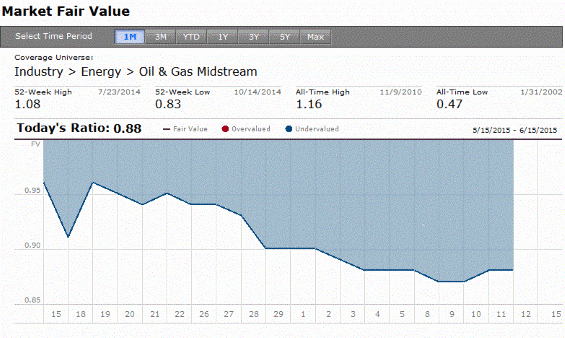3 Ways to Use Market Valuation Data
Learn whether the market is cheap or expensive--and what you can do about it.
Question: I find Morningstar's fair value estimates for companies to be useful. Do your analysts make an assessment about whether the whole market is cheap or expensive, too?
Answer: Although Morningstar equity analysts' chief focus is creating forward-looking assessments for individual companies, our Market Fair Value chart, accessible on the Markets tab of Morningstar.com, aggregates price/fair value estimates for all of those individual companies. As such, this interactive chart can help you see whether the market is cheap or expensive.
Although we don't recommend that investors make sweeping changes to a portfolio based on this information, it can definitely be useful to keep tabs on market valuation. Here's how to use the chart, as well as how its output might help in your portfolio oversight.
How Does It Work? The Market Fair Value chart is an interactive tool that provides a graphic depiction of the median price/fair value for stocks that Morningstar covers in all geographies. You can easily change the inputs to filter the universe and also adjust the time period.
The tabs on the left-hand side of the tool allow you to look at All Rated Stocks (meaning the median price/fair value of all stocks covered by Morningstar analysts in all geographies; this is the default view), or cull the universe down further, looking at rated stocks by sector or industry.
You can also filter by proprietary Morningstar data points such as Economic Moat (Morningstar analysts' assessment of whether a firm possesses sustainable competitive advantages) or Fair Value Uncertainty (the degree of confidence the analyst has in his or her Fair Value Estimate, taking into account sales predictability, operating leverage, financial leverage, and exposure to contingent events).
You can adjust the time period using the buttons across the top of the tool.
1. Use It to Set and Manage Expectations According to the Market Fair Value chart, the market is pretty fairly valued today (June 12), at 0.99 (1.00 would indicate that the median stock on our coverage list is fairly valued by price/fair value).
In terms of managing a portfolio, one could use market valuation information to set expectations for market performance and keep recent and future performance in context. That being said, we recognize that it's hard to make any predictions about near-term performance based on the aggregate data. As Morningstar StockInvestor editor Matt Coffina pointed out in this video from last year, oftentimes current market valuation levels say little about what stocks are going to do in the short term (one to three months from now) or even over somewhat longer time periods, such as one-, three-, or even five-year periods.
Aggregate valuation levels do have a larger impact on long-term performance, however. If the median stock in our coverage universe is undervalued, we would expect the stock market to appreciate beyond a fair risk-adjusted return over time. Likewise, if the median stock in our coverage universe indicated the market was overvalued, an eventual sell-off should not be a reason to panic, as it could be, at least partly, a reset to more reasonable valuations.
2. Use It for Rebalancing We wouldn't recommend eschewing a strategic portfolio plan based on current market valuations, whether overvalued or undervalued. We can't reliably predict when or how the market might come back to fair valuation, and we couldn't rule out that it might move even higher or lower in the short or intermediate term.
However, investors who are employing a strategic asset allocation plan, along with periodic rebalancing, might find the market valuation data helpful. Although monitoring your portfolio's current asset allocation relative to your targets should be the key factor behind any rebalancing activity, an extremely high price/fair value for the entire market could provide an additional impetus to scale back your stock weighting. Additionally, you can view various market subsets in our Market Fair Value chart--sectors, no-moat versus wide-moat stocks, and so forth--to help determine which market segments to tilt toward and which to pull back from.
And as Morningstar's head of global research Haywood Kelly pointed out in an article on the risk of timing in investing, even if valuation considerations only influence your decisions at the margin, the implications of a cheap or expensive stock market are significant. If the market is rich, you might reasonably maintain a slightly higher tilt toward cash or employ a measured approach to investing new monies in the stock market (through a drawn-out dollar-cost averaging plan, for example).
3. Use It to Start a Search for Opportunities A fairly valued market is perhaps not the most exciting news for bargain-hunters. But that doesn't mean there aren't some interesting prospects out there. You can use the sector valuation data to dig in and find undervalued parts of the market.
For instance, the chart indicates that the current median price/fair value of stocks we cover in the oil & gas midstream industry is 0.88.

- source: Morningstar Analysts
This could certainly serve as a catalyst for more research. For instance, you could use this information to look for mutual funds or exchange-traded funds with more exposure to an undervalued industry or sector, and then consider whether an appealing prospective fund would work in the context of an overall portfolio.
The quickest way to find individual stocks that Morningstar analysts like in an undervalued area of the market is to use our
. For example, I used the screener to find 4- and 5-star stocks with Economic Moats in the oil & gas midstream industry, using the following inputs:
- Stock Industry = Oil & Gas Midstream; and
- Morningstar Rating >= Four Stars; and
- Morningstar Economic Moat >= Narrow
Premium Members can click
to view the screen's complete output. This screen yields 12 results worthy of further investigation, including 5-star, wide-moat

/s3.amazonaws.com/arc-authors/morningstar/3a6abec7-a233-42a7-bcb0-b2efd54d751d.jpg)
/cloudfront-us-east-1.images.arcpublishing.com/morningstar/GQNJPRNPINBIJGIQBSKECS3VNQ.jpg)
/cloudfront-us-east-1.images.arcpublishing.com/morningstar/EC7LK4HAG4BRKAYRRDWZ2NF3TY.jpg)
/cloudfront-us-east-1.images.arcpublishing.com/morningstar/JNGGL2QVKFA43PRVR44O6RYGEM.png)
:quality(80)/s3.amazonaws.com/arc-authors/morningstar/3a6abec7-a233-42a7-bcb0-b2efd54d751d.jpg)